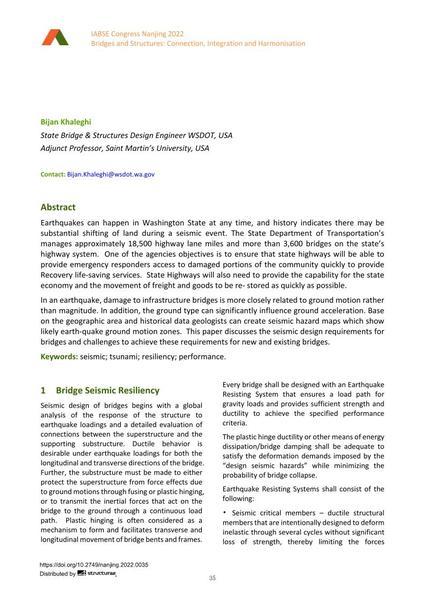Seismic and Tsunami Resiliency of Bridge and Transportation Structures

|
|
|||||||||||
Détails bibliographiques
| Auteur(s): |
Bijan Khaleghi
(State Bridge & Structures Design Engineer WSDOT, USA Adjunct Professor, Saint Martin’s University, USA)
|
||||
|---|---|---|---|---|---|
| Médium: | papier de conférence | ||||
| Langue(s): | anglais | ||||
| Conférence: | IABSE Congress: Bridges and Structures: Connection, Integration and Harmonisation, Nanjing, People's Republic of China, 21-23 September 2022 | ||||
| Publié dans: | IABSE Congress Nanjing 2022 | ||||
|
|||||
| Page(s): | 35-41 | ||||
| Nombre total de pages (du PDF): | 7 | ||||
| DOI: | 10.2749/nanjing.2022.0035 | ||||
| Abstrait: |
Earthquakes can happen in Washington State at any time, and history indicates there may be substantial shifting of land during a seismic event. The State Department of Transportation’s manages approximately 18,500 highway lane miles and more than 3,600 bridges on the state’s highway system. One of the agencies objectives is to ensure that state highways will be able to provide emergency responders access to damaged portions of the community quickly to provide Recovery life-saving services. State Highways will also need to provide the capability for the state economy and the movement of freight and goods to be re- stored as quickly as possible. In an earthquake, damage to infrastructure bridges is more closely related to ground motion rather than magnitude. In addition, the ground type can significantly influence ground acceleration. Base on the geographic area and historical data geologists can create seismic hazard maps which show likely earth-quake ground motion zones. This paper discusses the seismic design requirements for bridges and challenges to achieve these requirements for new and existing bridges. |
||||
| Copyright: | © 2022 International Association for Bridge and Structural Engineering (IABSE) | ||||
| License: | Cette oeuvre ne peut être utilisée sans la permission de l'auteur ou détenteur des droits. |
||||
